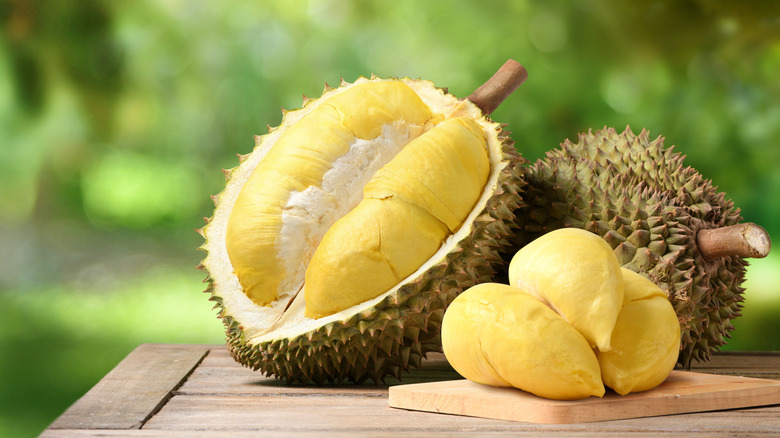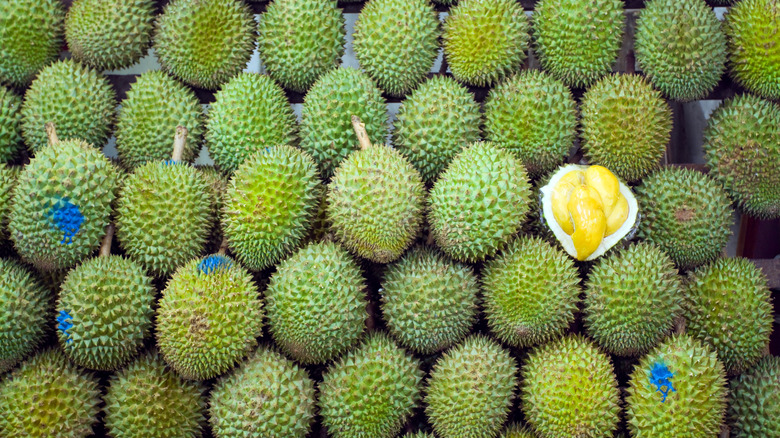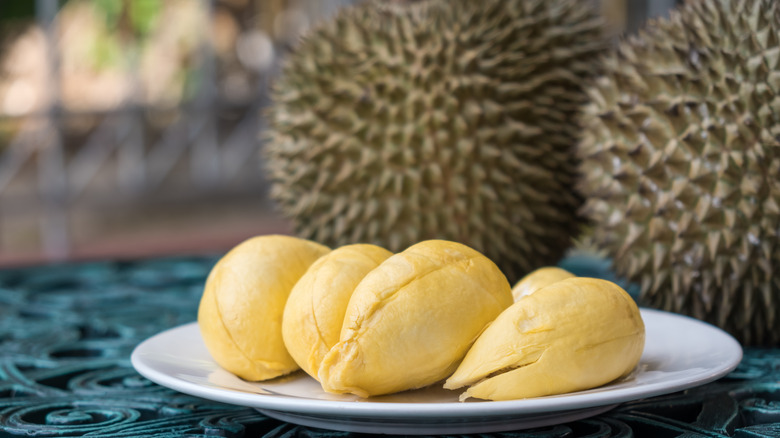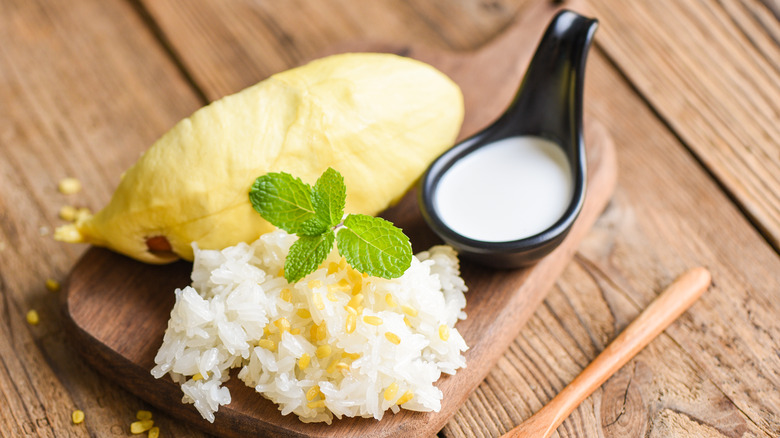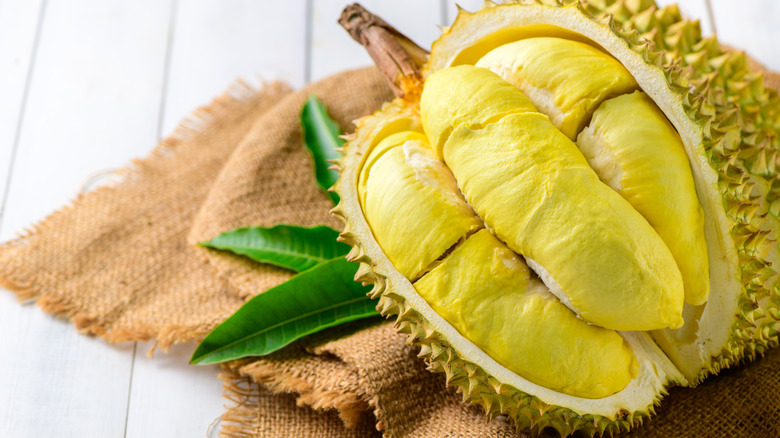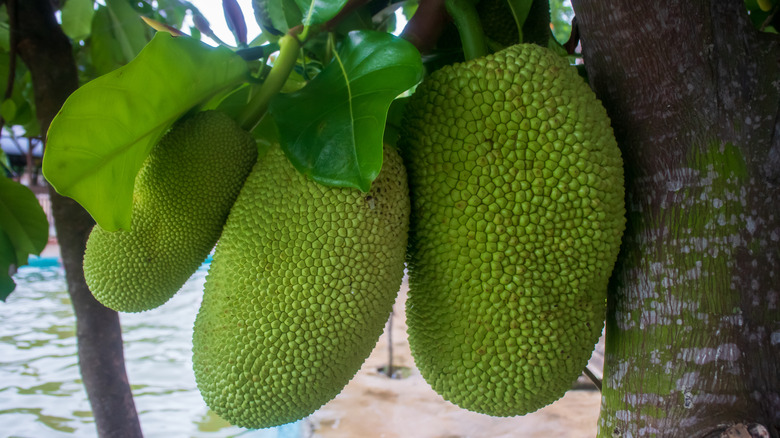What Is Durian And How Do You Eat It?
With its spiky outer skin and bright yellow interior, durian (Durio zibethinus) is a unique-looking fruit you might have spotted in your neighborhood Asian market. However, it's better known for its distinctive smell than its dramatic appearance. What is this smell? It's been described in many ways, but most people say it's like a sweet custard ... mixed with rotten onions and paint thinner.
This odor makes durian controversial, to say the least. But there's a reason it's known as "the king of fruit" — it tastes delicious. So, how does one get to sample the complexities of durian without being put off by the olfactory assault? Fortunately, the fruit's growing popularity has made it more available than ever before. And since durian is relatively simple to cook with, there are tons of ways to try it out.
What is durian?
Grown in the hot and humid climates of Malaysia, Thailand, Philippines, Vietnam, and surrounding regions, durian's custard-like flesh is considered a delicacy across Southeast Asia. In fact, there are dozens of durian festivals held across these countries, as well as in international hubs like Singapore and Hong Kong.
Durian is believed to have originated in the tropical mountainous islands of Borneo and Sumatra south of the Philippines. Of the 29 species of durio trees that have been found, only a handful produce an edible fruit. However, this group of tree species has been subdivided and cross-bred to give rise to literally hundreds of varieties of durian, each with its specific visual and flavor characteristics. The sizes of these spiny oblong fruits can range from six to 12 inches and weigh up to 18 lbs.
The eating experiences that durian offers are equally varied. Expensive specimens like the Malaysian Mao Shan Wang, which is known for its punchy yet complex tasting notes and creamy texture, are normally eaten as fresh as possible and without processing or cooking the pulp. Others, like the D24, aka Sultan, have a balanced bitter-sweet palate and are used to make durian-flavored dishes like ice-creams, cakes, smoothies, and a lot more. Several varieties are now available internationally, but there are also rare durian, like Dalits, that stand out with their blood-orange colored pulp and are typically only found at special durian tasting events.
What does durian taste (and smell) like?
Break it open, and the fruit, when ripe, reveals sections of soft yellow flesh and steady wafts of its characteristic aroma. The latter may make first-time eaters hesitate, but all too often, those who overcome their initial reactions soon become enthusiastic fans of the fruit.
Explorer Alfred Russel Wallace's letter to British botanist Sir William Hooker (subsequently published in Hooker's Journal of Botany Kew Garden Miscellany in 1856) described its enigmatic flavor as well as any modern first-time consumer of the fruit might, likening it to a "rich custard highly flavored with almonds ... but there are occasional wafts of flavor that call to mind cream cheese, onion-sauce, sherry wine and other incongruous dishes. Then there is a rich glutinous smoothness in the pulp which nothing else possesses, but which adds to its delicacy. It is neither acid, nor sweet, nor juicy; yet it wants none of these qualities, for it is in itself perfect. It produces no nausea or other bad effect, and the more you eat of it the less you feel inclined to stop."
Durian should always be eaten ripe, and since it only holds its consistency and flavor for only a few days, must be consumed quite quickly. The subtle flavors and custard-like texture will be missing in an unripe durian, while one that is over-ripe will have a nearly intolerable smell.
Cooked durian vs. eating it fresh
While ripe and raw is the best way to experience the fruit, cooked durian can be a more accessible way to consume it for first-timers. When eaten raw, the fruit is served in large chunks or even in entire plump sections that contain a seed that is not to be eaten. The sweet taste also makes durian a popular addition to desserts, and versions of a dish made with sticky rice, coconut milk, and raw durian are especially popular in Southeast Asia. Fresh durian is also commonly blended into smoothies and ice creams. Interestingly, the large size and short shelf life seem to have contributed to its reputation as a fruit that's eaten with company.
The fruit finds its way into savory dishes like soups, curries, and lumpia as well as desserts such as cakes, tarts, biscuits, and even ice cream. Canned durian or durian paste is often used in cooking as a substitute for fresh fruit, and durian-flavored confections are becoming more widely available. A testament to its fan following — you can even, according to one Twitter user, find durian-flavored toothpaste in certain markets.
Durian nutrition
Durian is, among other reasons, eaten for its nutritional benefits, and relative to other fruits, its high sugar and fat content make it particularly energy-dense. In addition to being a rich source of vitamins, minerals, fiber, and healthy fats, the leaves, husk, and roots, together with the fruit, are believed to have healing properties and are commonly used in traditional Malaysian medicine, according to Healthline.
Rounding out the list of benefits are its useful probiotic properties, when it's undergone a fermentation. In contrast, the durian seed is considered to be mildly toxic if consumed raw, though this is common among many tropical fruits. However, cooked versions of the seed — generally roasted or boiled — still find their way into recipes and are safe to consume when it has undergone the appropriate prep. Durian is still considered exotic, but its growing popularity and availability will make it more common in Western preparations as will the incidence of folks popping dried pieces of it as a snack outside of the tropics.
Buying fresh durian and storing it
You're most likely to find fresh durian in the summer months (between June and August) around the time it's harvested. While specialty fruit suppliers may deliver fresh durian near your home, with a shelf life of less than a week, finding one in its prime and ready to eat involves a bit of sleuthing. When looking for fresh durian, try to spot one that has an even green color without any dark brown patches. Look for ones that are oval or slightly oblong, as opposed to being completely round; avoid odd-shaped durians.
The multi-sensory experience starts early, so use your ears and nose to find the perfect piece. If it rattles when you shake it, chances are that the durian is too dry. A light, sweet fragrance emanating from the sides of the fruit means it is ready to eat. If the smell is too strong, it may be too ripe, and a lack of aroma means it's unripe.
If you find a specimen that's a few days away from ripening, you may leave it on your counter until it's ready to eat or slow down the process by refrigerating it. Even wrapped in paper, there is no escaping the smell, which will permeate wherever the fruit is kept. Ripe durian flesh can be frozen in an airtight container for over a month. Frozen and canned durian is also available more easily and can be stored for longer periods.
Durian vs. Jackfruit
Durian and jackfruit are both large tropical fruits that feature a similar tough green, spiky outer peel. Fortunately, it's easy to tell them apart, so you won't end up buying or eating jackfruit by mistake when you're out looking for durian. In fact, these fruits are not even of the same plant family, and their areas of origin are slightly different. Durian is a product of Southeast Asia; jackfruit is thought to have originated in Southern India.
While the former is by no means a small fruit, jackfruits are generally much larger (regularly crossing 50 lbs) and have a more uneven shape. Their insides are also quite different — the former has smooth sections of creamy flesh, while the latter is a maze of fibrous, chewy flesh and large edible seeds. Ripe jackfruit flesh does have a similar light yellow color and a pungent, slightly sweet smell (said to be the origin of Juicy Fruit gum's distinct flavor). However, durian's bitter-sweet flavor and complex aroma are unmistakable and decidedly more potent.
Why is durian banned in some places?
Durian's unique taste and aroma are a result of complex, volatile compounds, the effects of which are still being unraveled by researchers. Ester, sulfur, and alcohol compounds vary according to the species of durian in question, resulting in specific flavor and smell profiles.
This may not come as a surprise, considering much of the durian's notoriety stems from its potent smell, but the fruit has been banned from being carried on public transport and flights in multiple countries where it is found. Some local hotels even keep an eye out for guests who might be carrying the fruit, since the smell tends to linger in rooms and on clothes almost as much as it lingers on the tastebuds. Durian can now be purchased in vacuum-sealed packs, which can help contain the smell. However, it's recommended that you open the package outdoors or in a well-ventilated area so that only those who want to enjoy the fruit are privy to its legendary aroma.
